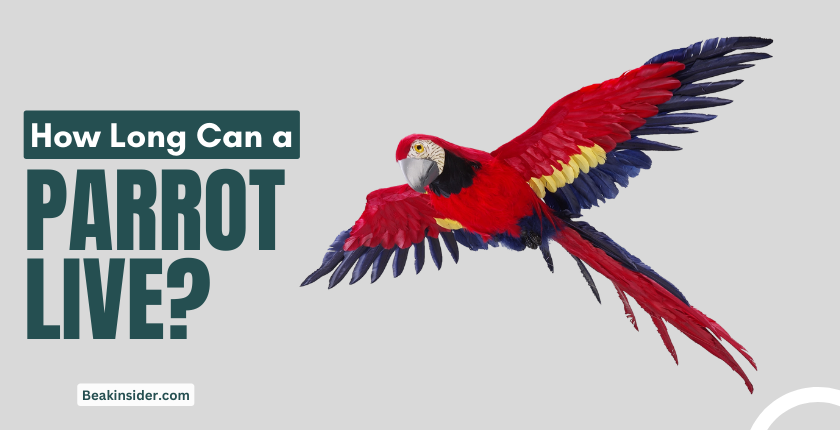The smaller species have a life period of 20 – 30 years, while larger species can live up to 50 years. On average, a parrot can live up to 50 years, but larger species can reach up to 80 or even 100 years as well.
The parrots comprise of broader order of more than 350 species, including parakeets, macaws, cockatiels, and many more, according to the Integrated Taxonomic Information System (ITIS).
They vary in size from small ones that can fit in the palm of your hand to large ones that are equal to the cat’s size. Just like sizes, their lifespan variate as well. As a general rule, the bigger the size of the parrot, the longer the lifespan is.
The Average Lifespan Of A Parrot – A General Rule
Parrots are considered to be special birds because many species have the power to be with you for your entire life. They are the best partners and often outlive their owners.
The answer to how long parrots live is even affected by how you define a “parrot”. This group of birds also includes small species, such as budgerigars and cockatiels, which have a smaller lifespan and bring down the average lifespan of parrots.
So, the clearest rule is the larger the parrot, the longer it is likely to live on average. Hence, macaws may live longer than budgies, and cockatoos may live longer than lovebirds.
Why Do Parrots Live So Long?
In general, birds live longer because of their body sizes compared to mammals. They have a higher metabolic rate, body temperature, and resting glucose than mammals. These factors are considered basic parameters for increasing the ages.
Another argument against why parrots live so long is their flying behaviour which helps them escape predation. Also, those animals that undergo exertion exercises have longer life spans than those that do not.
Moreover, parrots have a reduction in oxidative damage. This signifies that they have a lower level of reactive oxygen species (ROS) that helps reduce the damage associated with them, thus helping in long lives.
Moreover, several factors can influence the lifespan of a parrot. While individual variation exists, here are some key factors that can impact a parrot’s lifespan:
- Species: Different species of parrots have varying lifespans. Larger parrot species tend to have longer lifespans compared to smaller ones. For example, Macaws and Cockatoos can live for several decades, with some reaching 50-80 years or more, while smaller parrot species like Budgerigars (commonly known as budgies) have an average lifespan of 5-10 years.
- Genetics: Genetic factors play a role in a parrot’s lifespan. Some parrot species may have genetic predispositions to certain health conditions or longevity. Well-bred parrots from reputable breeders or those with a known lineage may have better health and longevity prospects.
- Diet and Nutrition: Proper nutrition is crucial for a parrot’s overall health and lifespan. A balanced diet consisting of high-quality pellets, fresh fruits, vegetables, and occasional treats is essential. Providing a varied and nutritionally rich diet helps prevent deficiencies and associated health issues.
- Environment and Enrichment: A stimulating and enriching environment is important for a parrot’s mental and physical health. Ample space to move, climb, and fly, along with interactive toys, social interaction, and mental stimulation, can contribute to a longer and happier life.
- Exercise and Physical Activity: Regular exercise is beneficial for a parrot’s physical health and mental stimulation. Allowing ample time outside the cage for supervised flying or providing opportunities for climbing and play can help maintain muscle strength and overall fitness.
- Emotional Wellbeing: Parrots are highly social creatures and thrive on social interaction and companionship. Providing opportunities for socialization with their human caregivers and, if applicable, other compatible parrots can positively impact their emotional well-being and, consequently, their lifespan.
- Stress Reduction: Minimizing stressors in a parrot’s environment is important for their overall health. Avoiding loud noises, sudden changes, and disruptions in routine can help reduce stress, which can impact their immune system and longevity.
Expert opinion: As a parrot lover and owner for a long time, providing a parrot with a caring, and enriched environment, along with proper nutrition greatly influence their lifespan. In my opinion, you must research the specific needs of the parrot species or consult with avian veterinarians or experienced parrot owners on their care practices.
Here, I have gathered the estimated life spans of different species of parrots to give you more accurate information.
How Long Do African Grey Parrots Live?
African grey parrots are intelligent and form strong bonds with their owners. They have been known to live for up to 80 years in captivity. They can pass through two to three generations of owners over the years. African grey parrots are known to be emotionally sensitive and hardly handle when bounced from owner to owner.
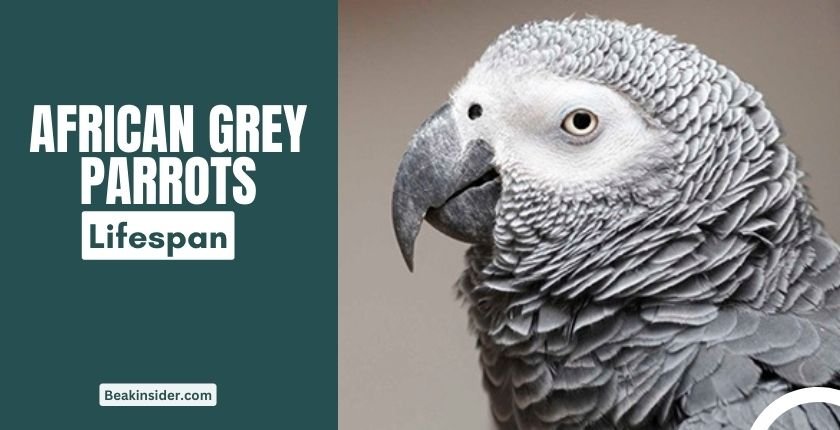
The Main Sub-Species of African Grey Parrots & Their Lifespans
- Congo African grey (CAG): Almost 40 to 60 years
- Timneh African grey (TAG): Almost 50 and up to 70 years
How Long Do Eclectus Parrots Live?
There is a different opinion on the lifespan of the Eclectus parrot. Some experts say that they can live an average of 30 years. In contrast, some say they can live up to 50 to 75 years. The truth lies somewhere between the minimum and maximum predicted lifespan. But, realize how you care for and raise your Eclectus parrot can alter its longevity.
Like other species, Eclectus parrots live longer in captivity than in the wild. This is due to several factors, such as they don’t have to worry about prey, get more food, and overall have better necessities than they have in the wild.
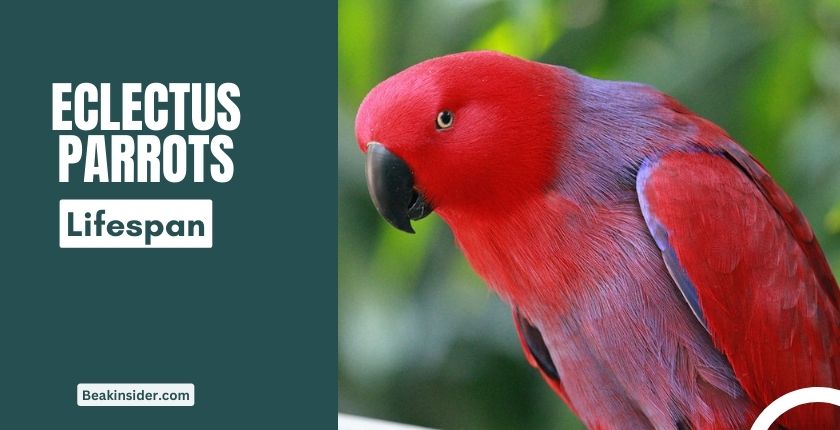
The Main Sub-Species of Eclectus Parrots & Their Lifespans
- Vosmaeri Eclectus: 30 years
- Grand Eclectus: 30 years
- Sumba Island Eclectus: 28 -29 years on average
- Tanimbar Island Eclectus: 40 years in the wild and almost 80 years in captivity
- Aru Island Eclectus: 40 years in the wild and almost 80 years in captivity
- Biak Island Eclectus: 40 years in the wild and almost 80 years in captivity
- New Guinea Red-Sided Eclectus: 30 to 40 years
- Solomon Island Eclectus: almost 30 years
- Australian Eclectus: an average of 30 years
How Long Do Macaw Parrots Live?
Like other parrots, macaw parrots can also live longer in captivity than in the wild. The smaller ones in the sub-species have a shorter life than the larger ones. However, the average life span of macaw parrots is between 25 to 60 years.
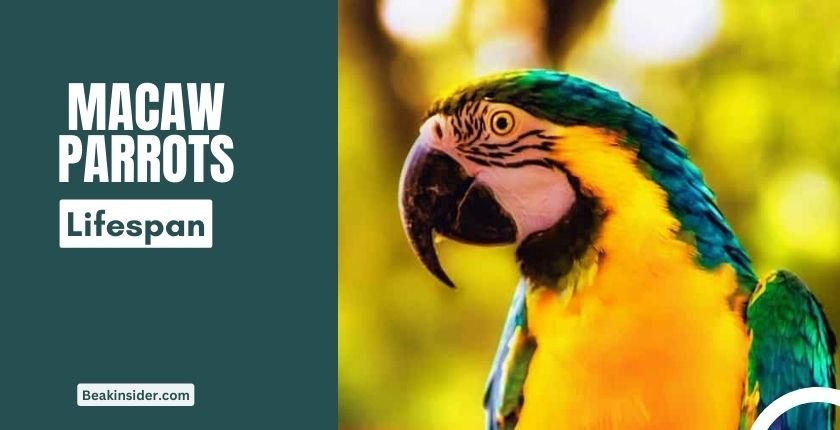
The Main Sub-Species of Macaw Parrots & Their Lifespans
- Glaucous macaw lifespan: 25 years in the wild and 50 years in captivity
- Hyacinth macaw lifespan: 50 years in the wild and almost 60 years in captivity
- Lear’s macaw lifespan: 30 years in the wild and up to 60 years in captivity
- Blue-and-yellow macaw lifespan: up to 30 years in the wild and 50 -60 years in captivity
- Green-winged macaw lifespan: 30 years in the wild and almost 70 years in captivity
- Blue-throated macaw lifespan: an average of 45 years in captivity
- Scarlet macaw lifespan: 40 years in the wild and an average of 45 in captivity
How Long Do Quaker Parrots Live?
Like many other parrots species, quaker enjoy longer lifespans in captivity than in the wild. Their average lifespan is 20 – 30 years. But, with care, they can live for more than 30 years.
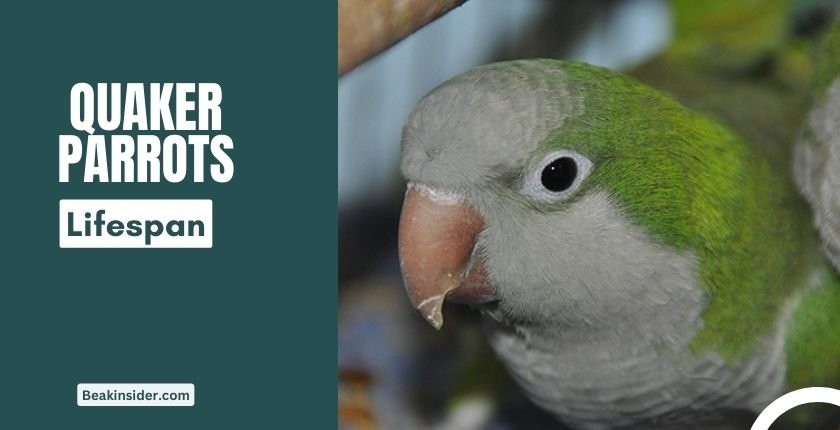
The Main Sub-Species of Quaker Parrots & Their Lifespans
- Myiopsitta monachus lifespan: 21 years
- Myiopsitta (monachus) luchsi lifespan: 20–30 years
- Myiopsitta monachus calita lifespan: 20–30 years
- Myiopsitta monachus cotorra lifespan: 20 -30 years
How Long Do Parrots Live In Captivity?
Well, there is no exact answer to this question. This is because different species of parrots have different life spans and hence different longevity in captivity. However, parrots may live 20 – 30 years more in captivity than in the wild. The reasons behind is that they get good food, protection from prey, and the owner’s attention and care.
Considerations
Parrots are not recommended as pets for children or people with uncertain life circumstances because of their long lifespan. If you adopt a parrot with a life expectancy of 50 to 80 years, then you need to make a consistent plan for its future care in case you get ill. If you are not sure that you would be able to take care of a parrot 40 to 50 years, then adopt the older one to save yourself from full lifetime care.
Related Articles:
- Can Parrot Eat Blueberries?
- Can Parrot Eat Radish?
- Can Parrot Eat Celery?
- Can Parrots Eat Asparagus?
- Can Parrot Eat Pomegranate?

I’m Amna, and I absolutely adore birds, especially parrots. I’ve been immersed in the world of these colorful feathered friends for over 10 years. While I’m not a bird doctor, I’ve gathered a wealth of knowledge on how to care for and understand them.
My experiences extend to various bird species like parrots, macaws, cockatoos, canaries, and finches. In addition to my personal adventures with birds, I’ve dedicated time to volunteering at a local bird rehabilitation center.
My true passion lies in sharing what I know about parrots and birds with you. Through my articles, I aim to share the information you need to provide the very best care for your avian companions. So, let’s embark on this journey together and make your feathered friends’ lives as joyful and healthy as possible!

